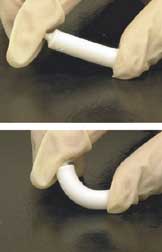
Photo from wikipedia
Chitosan with hydroxyapatite composition, a natural polymer, may be a biomaterial of importance for bone regeneration. Carbon nanotube, a nanoscale material, has been another focus for bone restoration. Zinc, an… Click to show full abstract
Chitosan with hydroxyapatite composition, a natural polymer, may be a biomaterial of importance for bone regeneration. Carbon nanotube, a nanoscale material, has been another focus for bone restoration. Zinc, an essential trace element, contributes to the development and growth of skeletal system. The purpose of the current research was to investigate the effects of Zinc-loaded Carbon Nanotubes/Chitosan composite biomaterials in the restoration of rat skull defects, and to verify the hypothesis that these zinc ions of appropriate concentration would strengthen the osteogenesis of rat defects. Four different groups of composite biomaterials were fabricated from no Zinc Carbon nanotubes/Chitosan (GN), 0.2% Zinc-Carbon nanotubes/Chitosan (GL), 1% Zinc-Carbon nanotubes/Chitosan (GM) and 2% Zinc-Carbon nanotubes/Chitosan (GH). After characterizations, these composite biomaterials were then transplanted into rat skull defects. The experimental animals were executed at 12 weeks after transplanted surgeries, and the rat skull defects were removed for related analyses. The results of characterizations suggested the Zinc-loaded composite biomaterials possessed good mechanical and osteoinductive properties. An important finding was that the optimal osteogenic effect appeared in rat skull defects transplanted with 1% Zinc-Carbon nanotubes/Chitosan. Overall, these composite biomaterials revealed satisfactory osteogenesis, nevertheless, there was a requirement to further perfect the zinc ion concentrations to achieve the better bone regeneration.
Journal Title: Journal of Materials Science: Materials in Medicine
Year Published: 2020
Link to full text (if available)
Share on Social Media: Sign Up to like & get
recommendations!